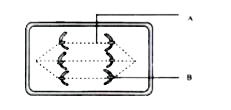For successful cell replacement during tissue repair, the chromosome content of each daughter cell must be identical to that of the mother cell. Which stages of mitosis make sure that each daughter cell receives one chromatid from each chromatid pair?
Prophase and metaphase
Metaphase and anaphase
Anaphase and telophase
Telophase and interphase
The correct Answer is:B
Step by step video & image solution for For successful cell replacement during tissue repair, the chromosome content of each daughter cell must be identical to that of the mother cell. Which stages of mitosis make sure that each daughter cell receives one chromatid from each chromatid pair? by Biology experts to help you in doubts & scoring excellent marks in Class 12 exams.
Updated on:21/07/2023Similar Questions
Knowledge Check
During meiosis I in humans, one of the daughter cells receives
Aonly material chromosomesBa mixture of maternal and paternal chromosomesCsame number of chromosomes as percent in parent cellDnone of these.Identify the figures numbering to a type of cell division showing different stages.

During Anaphase of mitosis, the position of the arms of chromatids are:ATowards the equator of the cellBTowards the poles of the cellCVaries from cell to cellDAt any place in the cell
The cells formed by meiotic division contain half the number of chromosomes and are identical to each other.
View SolutionThe diagram given below represents a certain stage of mitosis :

How many daughter cells are formed from this type of cell division?
View SolutionEach chromosome at anaphase stage of bone marrow cell in our body has
View SolutionName the stage of cell cycle at which one of the following events occur
Centromere splits and chromatids separate.
View SolutionExchange of chromosome segments between maternal and paternal chromatids during meiosis is called.
Or
In meiosis the daughter cells are not similar to that of parent because of
View SolutionIn an organism, if the normal diploid number of chromosmes is 8, how many chromatids are present in each daughter cell at the end of meiosis I
View Solution
